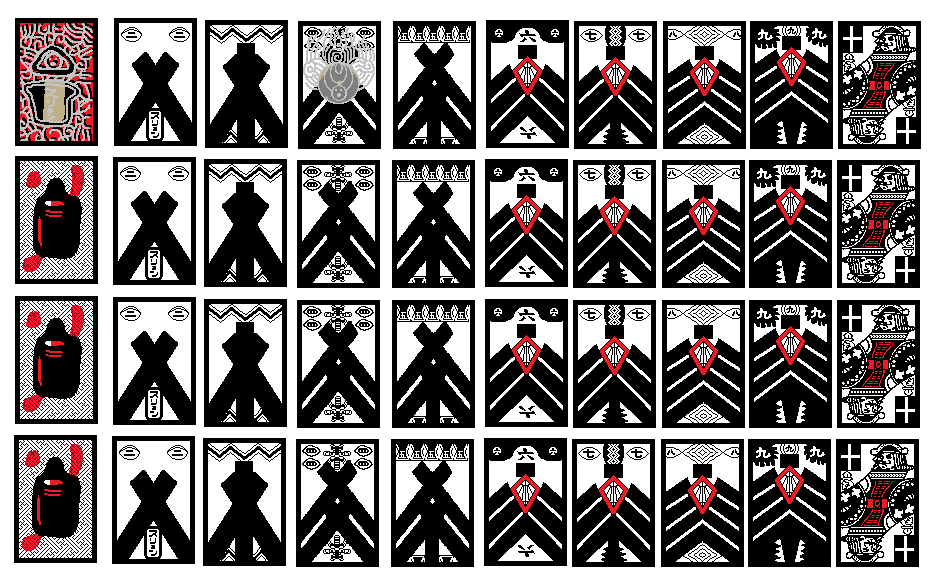Hiki-Kabu [引きカブ] is a Kabufuda game for 2-10 players.
Originally, the game was purely luck-based: the only decision made by the players during gameplay is asking for a third card, which may or may not be limited to the rules also applied in Oicho-kabu.
An additional gameplay element similar to poker was added to heighten the skill involved in the game. This gives the game a slightly similar gameplay style to those of Kachi-Kachi and Seotda.
¶ Equipment
Hiki-Kabu is played with a kabufuda deck.

This simple deck contains 40 cards, consisting of four identical series of the numbers 1 to 10.
Since kabufuda decks are somewhat uncommon, they are often emulated with a hanafuda deck by removing all November and December cards and assigning values to the remaining cards based on month order. So all January cards are 1, February cards are 2, and so on, up to October which is 10.
Alternatively, one can take an international 52-card deck and remove all Kings, Queens, and Jacks, leaving only the pip cards. Ignoring suits (and counting the Aces as 1), the result is exactly equivalent to a kabufuda deck.
Additionally, it is recommended to use chips or other small counters to keep track of bets and players’ scores.
¶ Gameplay
For the initial hand, determine the dealer using a method of your choice. For subsequent hands, the winner of the previous hand will deal the following hand. In the event of a draw, the dealer of the drawn hand will deal the following hand.
Before the game starts, determine the amount of chips for the ante, which is also equal to the minimum bet size a player can make.
¶ First Card
Each player then antes the agreed amount, and the dealer deals each player their first card face-up.
¶ Second Card
After the first card has been dealt to each player, the dealer then deals each player their second card face-down. This second card may only be looked at by the player who holds it.
The combination of the first and second cards forms a player’s hand.
Each player checks their own cards to determine the strength of their hand. Each player, starting from the dealer counter-clockwise, may request to add a 3rd card into their hand.
¶ Third Card
Players who asked for a 3rd card is dealt a 3rd card face-up by the dealer.
¶ Betting Round
The dealer begins the hand with the option to make an opening bet equal to or greater than the minimum bet size or fold their hand. Continuing clockwise, each player then has the option to match the dealer’s bet, raise it to double the amount, or fold their hand.
If the dealer folds, the next player then has the option to make an opening bet or fold following the same rules. If all players except one fold, the last remaining player collects the pot without proceeding to showdown.
If the bet is raised, then all other players who haven’t folded must either match that bet, raise it even further, or fold.
After all remaining players have placed equal bet amounts, they proceed to showdown.
¶ Showdown
Starting with the dealer (or closest player in order), each player reveals all their cards. Hands are evaluated according to the Hand Rankings chart below. The winner of the hand collects the pot and becomes the dealer for the next hand.
Depending on the hand, there will be a multiplier in the earnings of the winner; this will be applied to the bets of other players who participated in the showdown.
In the case of a draw, the pot for the hand carries over to the next hand, and the dealer for the drawn hand deals the following hand.
¶ Hand Rankings
Most of these hands come from the local Yaku rules of Oicho-Kabu.
-
Sequence of cards do not matter except for “Nobori” and “Kudari”.
-
If there are two players who have both Nobori or both Kudari, then the strength is determined by the ones digit of the sum of the cards.
-
Also, 2-card hands are invalidated if a 3rd card is added.
| MULTIPLIER | HAND | CARDS |
|---|---|---|
| 5x | 1. Doshippin | 10, 10, 1 |
| 5x | 2. Arashi-kabu | 3, 3, 3 (i.e. a Triplet whose ones digit of sum of cards is 9) |
| 3x | 3. Arashi | Other Triplets. If two players have “Arashi”, it is a draw, regardless of the hands’ values. |
| 3x | 4. Nana-Go-San | 7, 5, 3 |
| 3x | 5. Ichi-Ni-San | 1, 2, 3 |
| 3x | 6. Raijin | 4, 7, 9 |
| 3x | 7. Fujin | 3, 7, 10 |
| 3x | 8. Nobori | Straight up (ex. 3, then 4, then 5) Note: you cannot follow 10 with 1. |
| 3x | 9. Kudari | Straight down (ex. 5, then 4, then 3) Note: you cannot follow 1 with 10. |
| 2x | 10. Kuppin | 9, 1 |
| 2x | 11. Shippin | 4, 1 |
| 2x | 12. Toichi | 10, 1 |
| 2x | 13. Tsuru | 2, 2 |
| 2x | 14. Gogo | 5, 5 |
| 1x | 15. None of the above | If your hand does not match any of the hands above. The strength is determined by the ones digit of the sum of the cards. |
¶ Old Version (Variant)
The old version of this game features a very simple gameplay style, and is purely luck-based.
¶ First Card
After the dealer is chosen, the dealer shuffles the deck and deals each player their first card.
Each player then antes the agreed amount.
¶ Second Card
After the ante is placed, the dealer then deals each player their second card.
The combination of the first and second cards forms a player’s hand.
It has not been attested if the first card is face up and the second card is face down, or if it is reversed. Basically either method may be used as long as one card is face up and the other card is face down.
The face-down card may only be looked at by the player who holds it.
Each player checks their own cards to determine the strength of their hand. Each player, starting from the dealer counter-clockwise, may request to add a 3rd card into their hand.
It has not been attested, but it seems there are two rules that affect this decision:
- If a hand’s total value is 3 or lower, then a third card must be taken.
- If a hand’s total value is 7 or higher, then a third card cannot be taken.
¶ Third Card
Players who asked for a 3rd card is dealt a 3rd card face-up by the dealer.
There is no betting round.
After the 3rd cards have been dealt, all players proceed to showdown.
¶ Showdown
Starting with the dealer, each player reveals all their cards.
Since hand rankings were not attested, it is assumed that the ones digit of the sum of the cards is used to determine a hand’s strength.
The winner of the hand collects the pot and becomes the dealer for the next hand.
In the case of a draw, the pot for the hand carries over to the next hand, and the dealer for the drawn hand deals the following hand.
¶ Bō-Pin (Hiki-Kabu variant)
Bō-Pin [ボーピン] is a Hiki-Kabu variant for 2-10 players.
It is attested to be played using a 48-card Hanafuda deck, using the Nagoya month sequence.
You may also play using a stripped western playing card deck. Remove all 10’s from the deck.
Rules are mostly identical to the old version of Hiki-Kabu, but with differences:
- Unlike in Hiki-Kabu, where all players are pitted against each other, in Bō-Pin, the players are all pitted against the dealer.
- The third card is always given whether the player asked for it or not.
- There are 2 Special Yaku in the game, which can only be formed by the dealer.
¶ First Card
After the dealer is chosen, the dealer shuffles the deck and deals each player (including the dealer) their first card.
Each bettor (dealer not included) then antes the agreed amount.
¶ Second Card
After the ante is placed, the dealer then deals each player their second card.
The combination of the first and second cards forms a player’s hand.
It has not been attested if the first card is face up and the second card is face down, or if it is reversed. Basically either method may be used as long as one card is face up and the other card is face down.
The face-down card may only be looked at by the player who holds it.
Each player checks their own cards to determine the strength of their hand. Each player, starting from the dealer counter-clockwise, may request to add a 3rd card into their hand.
It has not been attested, but it seems there are two rules that affect this decision:
- If a hand’s total value is 3 or lower, then a third card must be taken.
- If a hand’s total value is 7 or higher, then a third card cannot be taken.
¶ Third Card
Players who asked for a 3rd card is dealt a 3rd card face-up by the dealer.
After the 3rd cards have been dealt, all players proceed to showdown.
¶ Showdown
Starting with the dealer, each player reveals all their cards.
The ones digit of the sum of the month numbers of the cards is used to determine a hand’s strength.
- If the dealer’s hand totals greater than a bettor’s hand, then the dealer wins; they take for themselves any bets placed on that hand by the players.
- If the dealer’s hand totals less the a bettor’s hand, then the player wins. Any player who bet on that hand wins an amount equal to their bet, in addition to having their bet returned to them, for a total payout of 2:1. (If playing for money, then a fraction of the winnings go to the dealer as “rental fee” [寺銭 - てらぜん, terazen] for the gambling parlor.)
- If the dealer’s hand and a bettor’s hand are equal in value, then this is a draw.
In the case of a draw, either the dealer wins, or the bet is returned to the bettor. This must be decided before playing the game.
¶ Special Cards
All cards of the ![]() 10th,
10th, ![]() 11th, and
11th, and ![]() 12th months of the deck (Maple, Peony, and Plum Blossom) are considered special cards [ボー繪, bō-e].
12th months of the deck (Maple, Peony, and Plum Blossom) are considered special cards [ボー繪, bō-e].
¶ Special Yaku
- “Scraping the Bō-Pin” [ボーピン掻きたくり, bōpin kakitakuri] - If the dealer’s hand contains a special card and a
 Pine card, then the dealer wins against all bettors.
Pine card, then the dealer wins against all bettors. - “Three Bō Laughter” [三ボー笑ひ, sanbō warai] - If the dealer’s hand contains three special cards of the same month, then the dealer wins against all bettors.
¶ Bō-Ni (Hiki-Kabu variant)
Bō-Ni [ボー二] is a Hiki-Kabu variant for 2-10 players.
It’s rules are identical to Bō-Pin, except one of the Yaku has one of the cards replaced with a different card.
¶ Special Yaku
- “Scraping the Bō-Ni” [ボー二掻きたくり, bōni kakitakuri] - If the dealer’s hand contains a special card and a
 Willow card, then the dealer wins against all bettors.
Willow card, then the dealer wins against all bettors. - “Three Bō Laughter” [三ボー笑ひ, sanbō warai] - Same as in Bō-Pin.
¶ References
- 【花札ゲーム紹介】引きカブ遊び方の紹介です。和製ポーカー!時代を超えて、熱い駆け引きをお楽しみいただけます。この動画を見れば引きカブの遊び方が分かり、即プレイ可能です! - (YouTube)
- Takeshi Ichinose, “Atarashii Hanafuda Nyuumon”
- Tobaku Ni Kansuru Chōsa. vol. 121, Shihōshō Chōsaka, 1927, National Diet Library, dl.ndl.go.jp/info:ndljp/pid/1269696. pp. 44